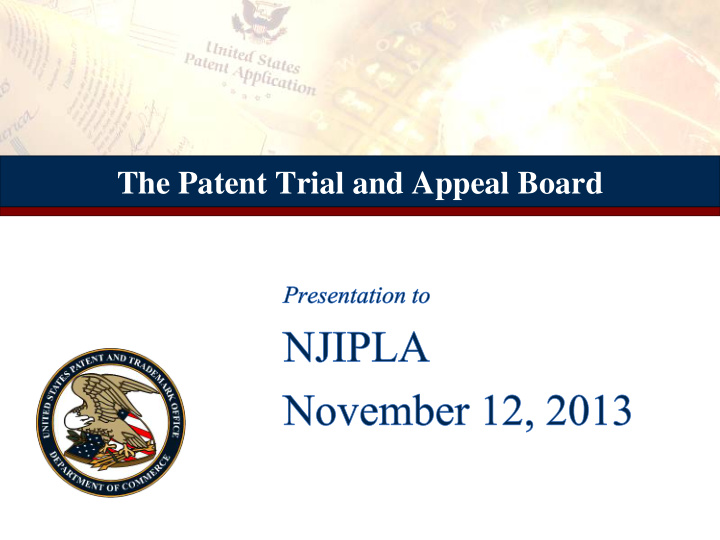



The Patent Trial and Appeal Board
Members of the Board Currently, 177 members 2
Judges and Offices (as of October 3, 2013) 177 Administrative Patent Judges Selection continues 5 Offices Washington, DC (Alexandria and Arlington, VA) Elijah J. McCoy Office (Detroit) Denver Dallas Silicon Valley (Menlo Park)
AIA Trial Proceedings
New Regulations: 37 C.F.R. § 42 Part 42 –Trial Practice Before the Patent Trial and Appeal Board Subpart A – General Provisions: 37 C.F.R. §42+ Subpart B – Inter Partes Review: 37 C.F.R. §42.100+ Subpart C – Post-Grant Review: 37 C.F.R. §42.200+ Subpart D – Transitional Program for Covered Business Method Patents: 37 C.F.R. §42.300+ Subpart E – Derivation Proceedings: 37 C.F.R. §42.400+ 5
Federal Register Final Rules General Administrative Trial Final Rules 77 Fed. Reg. 48612 (August 14, 2012) Inter Partes , Post Grant, and Covered Business Method Review Final Rules 77 Fed. Reg. 48680 (August 14, 2012) Covered Business Method and Technological Invention Definitions Final Rules 77 Fed. Reg. 48734 (August 14, 2012) Trial Practice Guide 77 Fed. Reg. 48756 (August 14, 2012) Change to Implement Derivation Proceedings 77 Fed. Reg. 56068 (Sept. 11, 2012) Inter Partes Review Technical Correction Final Rule 78 Fed. Reg. 17871 (March 25, 2013) 6
AIA Trial Proceedings Statistics
AIA Progress (FY2013) Number of AIA Petitions Total IPR CBM DER 514 48 1 563 Petition Technology Breakdown (10/3/13) Technology No. of Petitions Percentage Electrical/ 405 68.4% Computer 84 14.2% Mechanical 55 9.3% Chemical 43 7.3% Bio/Pharma 5 0.8% Design
AIA Progress (FY2013) Patent Owner Preliminary Responses Filed Waived 236 62 IPR 33 2 CBM AIA Petition Dispositions Instituted Denials Joinders Total Trials IPR 168 25 10 203 CBM 14 3 17
AIA Progress (FY2013) AIA Final Dispositions Final Written Settlements Decisions 38 1 IPR 3 1 CBM Petitions are being filed at the rate of about 2.5 per day (as of October 3, 2013)
Top Patent Litigation Venues Eastern District of Texas 1266 District of Delaware 995 PTAB 563 Central District of California 514 Northern District of California 260 FY 2012 data used for District Courts FY2013 data used for PTAB 11
AIA: Faster and Cheaper? Time to trial in district court Median 2.5 years Patent Litigation Cost (per AIPLA 2011 Survey) At risk Average, all costs, per party < $1M $916,000 $1–25M $2,769,000 > $25M $6,018,000
Observations on Trial Practice
Standard Timeline
Petitions: Compliance Circumventing page limit: 37 C.F.R. § 42.6 Exhibit labeling and numbering: § 42.63 Mandatory notices: § 42.8 Include in petition; count toward page limit Related proceedings: § 42.8(b)(2) “any other judicial or administrative matter that would affect, or be affected by, a decision in the proceeding.” Claim charts Claim construction required: § 42.104(b)(3)
Petitions: Substance Better to provide detailed analysis for limited number of challenges, rather than identify large number of challenges for which little analysis is provided Support conclusions with: Sound, complete legal analysis Pinpoint citations to evidentiary record
Claim Construction Standard: broadest reasonable construction in light of the specification of the patent in which claim appears (unexpired patent) 37 C.F.R. § 42.100(b) Most cases require more construction than mere restatement of the standard Justify a proposed construction with evidence The Board will construe terms even if the parties do not
Claim Charts Purpose of claim charts is to summarize the evidence , not the argument Claim charts support narrative analysis; they do not replace it Use two-column format (see FAQ D13 at www.uspto.gov/ip/boards/bpai/prps.jsp) Provide pinpoint references to the evidence (see FAQ D12)
Expert Declarations Focused tutorials may help Provide underlying objective facts to support testimony; unsupported testimony is entitled to little or no weight 37 C.F.R. 42.65(a); see IPR2013-00022, Paper 43 (denying petition) Avoid merely “expertizing” claim charts and analysis
Obviousness Challenges Apply the Graham factors Explain the rationale to combine Support the rationale to combine with evidence Differentiate multiple grounds to avoid redundancy denials. See CBM2012-00003, Paper 7 (denying redundant grounds)
Patent Owner Preliminary Response Patentability is not decided at institution stage Focus arguments on dispositive issues: Standing (statutory bar, RPI/privy issues) Reference is not prior art Prior art lacks a material limitation or teaches away Unreasonable claim construction Arguments not raised in preliminary response are not waived
Additional Discovery Five-factor test articulated in IPR2012-00001, Garmin v. Cuozzo, Paper 26: 1. More than a possibility and mere allegation? 2. Seeking opponent’s litigation position early? 3. Ability to generate by other means? 4. Instructions clear? 5. Overly burdensome to answer? Documents: more likely to grant specific, relevant, requests than general requests
Depositions Federal Rules of Evidence apply Objections to admissibility waived Follow the Testimony Guidelines (Practice Guide Appendix D) No “speaking” objections or coaching Instructions not to answer are limited
Joinder Must be a like review proceeding Requires filing a motion and petition File within one month of institution Impact on schedule important
Post Grant Resources Information concerning the Board and specific trial procedures may be found at: www.uspto.gov/ptab General information concerning implementation of the Leahy-Smith America Invents Act, including post grant reviews, may be found at: www.uspto.gov/aia_implementation 25
Representative Decisions See www.uspto.gov/ip/boards/bpai/ representative_orders_and_opinions.jsp Examples of orders, decisions, and notices at various stages of proceedings
Questions? PTAB Web Page www.uspto.gov • Click on “PTAB” Circle (left side, halfway down) • statistics, argument dates, opinions, the interference web portal, standard operating procedures, rules and other information 571-272-9797 • Staffed every weekday 8:30 a.m. to 4:30 p.m. 572-272-INTF (4683) • Interference procedural questions ONLY 27
Recommend
More recommend